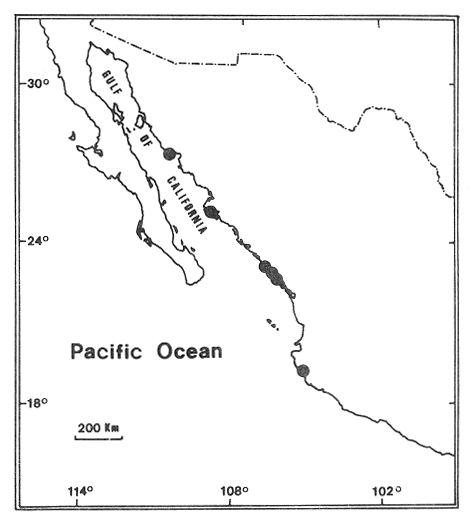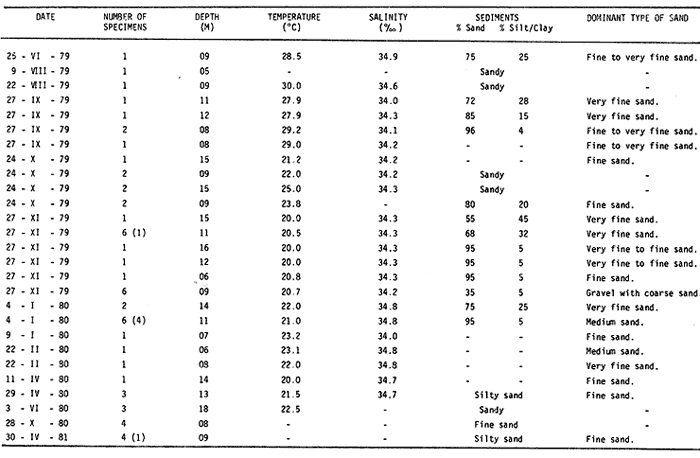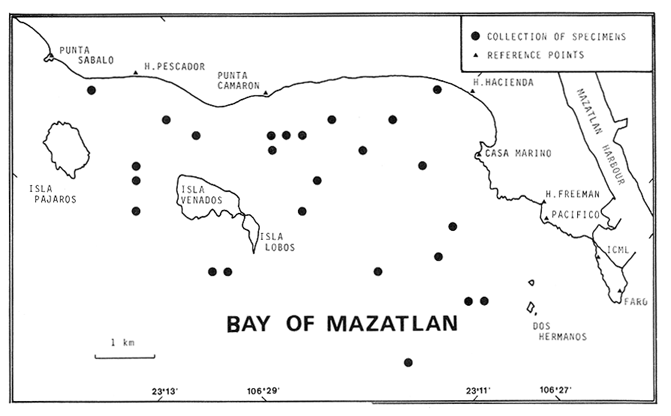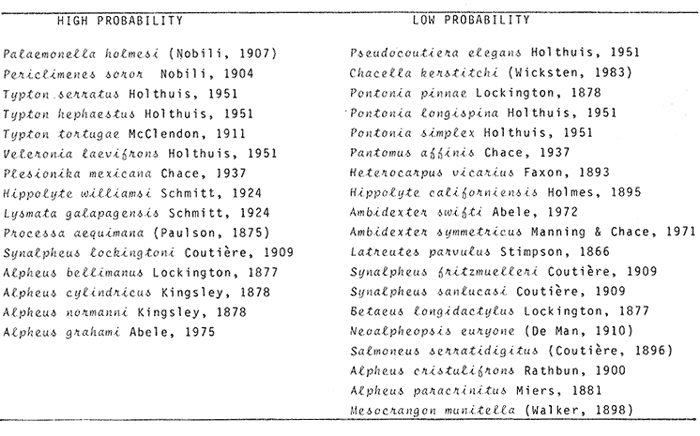|
STUDIES OF THE COASTAL MARINE FAUNA OF
SOUTHERN SINALOA, MEXICO. VIII. ADDITIONAL REPORT ON THE CARIDEAN
CRUSTACEANS
Trabajo recibido el 15 de julio de 1985 y aceptado para su
publicación el 21 de mayo de 1986.
Michel E. Hendrickx
Universidad Nacional
Autónoma de México, Instituto de Ciencias del Mar y
Limnología, Estación Mazatlán, Apto. Postal 811,
Mazatlán, Sinaloa, México.
Mary K. Wicksten
Texas A &
M University, Department of Biology, College Station, Texas 77843.
Contribución 514 del Instituto de Ciencias del Mar y Limnología,
UNAM.
Se citan catorce especies de carideos
en aguas marinas, salobres y dulces en la parte sur de Sinaloa, en el Golfo de
California, incluyendo un primer registro para Ogyrides
alphaerostris en el Pacífico Este Tropical. En total son 43
las especies de camarones carideos que han sido colectadas hasta la fecha en el
área.
ABSTRACT
Fourteen species of caridean
crustaceans are reported for marine, brackish and fresh water habitats in
Southern Sinaloa, in the Southeastern Gulf of California, including a first
record of Ogyrides alphaerostris for the Tropical Eastern
Pacific. This brings to 43 the number of species of caridean shrimps collected
in the area.
In a first publication dealing with the caridean shrimps of the Southern Sinaloa area, Hendrickx et al. (1983) reported 29 species from different depths or habitats. Since, two of these species were described as new (Wicksten, 1983) and 12 additional species were found for the first time along the coast of Southern Sinaloa. The purpose of this paper is to complete the list of caridean shrimps occurring in this area and to establish a compafison with the caridean fauna of the Gulf of California such as it is presently know. METHODSMost of the material reported herein was collected by hand in fresh water streams, in brackish lagoons or in the rocky intertidal. In some cases (rock-pool) a fishkiller was used which proved to be quite efficient with Alpheidae and Porcellanidae. In the Bay of Mazatlán, specimens were obtained during a two-year sampling program aboard the FC-1, a small PP vessel of the Secretaría de Educación Pública, in Mazatlán, using a small otter traw1 and a Van Veen grab. Specimens from the continental shelf were collected off the coast of Sinaloa aboard the ocenographic vessel "El Puma" of the Instituto de Ciencias del Mar y Limnología, Universidad Nacional Autónoma de México, with a oyster dredge or with a Van Veen grab; most of this material was taken during a three-leg project (sipco project) including the study of the benthic community off the coast of Southern Sinaloa. Environmental conditions (depth, temperature, salinity and dissolved oxygen) were taken from Orozco-Romo (1980) and Hendrickx et al. (1984). Informations related to sediments structure in the Bay of Mazatlán were also taken from OrozcoRomo (1980), while sediments composition at sampling stations off the coast of Sinaloa were provided by the Laboratorio de Geología Marina of the Estación Mazatlán, UNAM. The abbreviation T.L. refers to total length of specimens. RESULTS
Family Atyidae
Atya crassa (Smith, 1871) Material A single specimen collected in Río Baluarte (25 April 1981). Previous Eastem Pacific records. The species has been collected in 14 localities, including 3 in México (Río Presidio and Río Baluarte, Sinaloa; Río Tehuantepec, Oaxaca). Range. From Southern Sinaloa, México, to Ecuador (Hobbs and Hart, 1982; Hendrickx and van der Heiden, 1983). Habitat. In fresh water streams. Together with A. crassa, there is a total of 4 species of Atya presently know from the Pacific slope of México (Hobbs and Hart, 1982). Family Palaemonidae
Macrobrachium acanthochirus Villalobos, 1966 Material A male specimen collected in Río Baluarte (1981). Previous Eastern Pacific records. This species is known from only two localities in México (Pochutla and Tecomán, Colima). Range. From Río Baluarte, Southern Sinaloa, to Colima (Hendrickx and van der Heiden, 1983). Habitat. In fresh water streams. The present record brings to 5 the number of species of Macrobranchium known from the drainage system of Southern Sinaloa (Hendrickx et al., 1983). Palaemon (Palaemon) ritteri Holames.1985 Material. Eigth specimens (including 2 ovigerous females) from Punta Sabalo, Bahía de Mazatlán (3 December 1982); 8 specimens from Puerto Viejo, Bahía de Mazatlán (March and April 1983). Previous Eastem Pacific records. Many localities, including the Gulf of California where the species has been reported along both coasts (Holthuis, 1952; Wicksten, 1983). Range. From San Diego, California, to Paita, Perú, and Islas Galápagos, Ecuador (Holthuis, 1952). Habitat. In Southern Sinaloa, the species is found on rocky shores, principally in tide-pools and under rocks at low tide. It is also found in clumps of Padina durvillae Bory in shallow water in the Bay of Mazatlán (SánchezVargas, 1984), where many species of decapod crustaceans are associated with algae (Sánchez-Vargas and Hendrickx, 1987). Brachycarpus biunguiculatus (Lucas, 1849) Material. One specimen from Puerto Viejo, Bahía de Mazatlán (24 March 1983); two specimens from Isla Pájaros and Cerro del Vigía, Bahía de Mazatlán (15 March 1984). Previous Eastem Pacific records. Many localities; from México to Colombia and Islas Galápagos; in the Gulf of California, the species is reported from the tip of the Baja California Península (Punta Arena to Cabo San Lucas) (Wicksten, 1983). Range. From Punta Arena and Bahía de Mazatlán, south to Colombia (Isla Gorgona); Isla Cocos, Costa Rica and Galápagos, Ecuador (Sánchez-Vargas, 1984). Habitat. All specimens were found under rocks in the low intertidal. Family Hippolytidae
Lysmata galapagensis Schmitt, 1924. Material There specimens, including one ovigerous female from Isla Pájaros, Bahía de Mazatlán (15 March 1984); there specimens from Cerro del Vigía, Bahía de Mazatlán (16 March 1984). Previous Eastern Pacific records. Bahía Magdalena, West coast of Baja California and Gulf of California (two localities in Sonora); Islas Marías, Nayarit (Gulf of California sensu lato) and Acapulco, Guerrero; Panamá; Islas Galápagos, Ecuador (Wicksten, 1983). Range. México to Panamá; Islas Galápagos, Ecuador (Wicksten, 1983). Habitat. Under rocks in the low intertidal. Lysmata intermedia (Kingsley, 1878) Material. The material from Mazatlán reported by Wicksten (1983), was not included in the previous report on caridean crustaceans from Southern Sinaloa (1 specimen; 27 November 1979). Additional material from the same area includes 1 ovigerous female (24 October 1974) and another specimen obtained the 27th of November 1980; all specimens were collected with an otter-trawl (FC-1). Previous Eastern Pacific record. Bahía Magdalena, Baja Califoria Sur; several loacalities along the continental coast of México, from Guaymas, Sonora, to Matachen Beach, Nayarit; Tumbes, Perú (Wicksten and Méndez, 1983). Range. Bahía Magdalena and Guaymas, Gulf of California, south to Tumbes, Perú. Habitat. Sandy bottom (fine to very fine sand with up to 25% silt/clay) from 8 to 24 m. Processa peruvianaWicksten, 1983 Material. Apart form the type material reported by Wicksten (1983) (1 ovigerous female), three additional specimens have been collected off the coast of Southern Sinaloa, all whit Van Veen grab (Table l). Previous Eastem Pacific records. The species has been reported from the Western coast of Baja California and the Gulf of California, south of Perú in as many as 20 sampling stations (Wicksten, 1983). Range. From Isla San Benito, Baja California; Punta Piaxtla and Isla Montserrate, in the Gulf of California, South to Mancora, Perú. Habitat. The material from Southern Sinaloa was collected between 37 and 72 m; sampling conditions varied considerably (temperature from 14.2 to 26.4°C; dissolved oxygen from 1.00 to 4.13 ml/l; sediments from sandy to muddy sand) (Table l), except salinity (34-35°/oo). Family Alpheidae
Alpheus sulcatus Kingsley, 1878 Material. Eleven specimens, including 4 ovigerous females, from Isla Pájaros, Bahía de Mazatlán (15 March 1984) (Maximum size of males, 57 mm T.L.; of females, 47 mm T.L.). Previous Eastern Pacific records. Southern Gulf to Colombia and Isla Galápagos (Wicksten, 1983). Range. From Mazatlán, Sinaloa, and Banco Arena, Baja California, South to Colombia; Isla Socorro and Galápagos; Eastern Atlantic (Wicksten, 1983). Habitat. Under stones in the low intertidal. Remarks. Alpheus arenensis Chace (1937) was reccntly synonymized with A. websteri (Wicksten, 1983).  TABLE 1. SPECIMENS OF PROCESSA PERUVIANA COLLECTED OF THE COAST OF SOUTHERN SINALOA Alpheus splendidus Coutiére, 1897 Material. One specimen from Cerro del Vigía, Bahía de Mazatlán (16 March 1984). Previous Eastern Pacific records. San Carlos (Guaymas), Sonora (Wicksten and Hendrickx, 1985). Range. Eastern coast of the Gulf of California, from San Carlos to Mazatlán; Indo-Pacific (Wicksten and Hendrickx, 1985). Habitat. Rocky intertidal, in tide-pool. Alpheus mazatlanicus Wicksten, 1983 Material In the first report on caridean crustaceans from Southern Sinaloa, the species was cited as Alpheus cf A. malabaricus Fabricius and was since described as a new species belonging to theA. malabaricus complex: Alpheus mazatlanicus (Wicksten, 1983). Additional material of A. mazatlanicus was recently obtained from the Barra de Navidad lagoon, Jalisco (6 spécimens) and from several others localities in the Gulf of California, including the La Lechugilla lagoon (1 specimen; 9 November, 1985), Topolobampo, Sinaloa (1 specimen, collected in an estero; 12 April, 1984) and the Estero San Carlos, near Guaymas, Sonora (2 spécimens; 6 February, 1986), thus extending the known distribution range of this species approximately 500 km southward and 650 km northward. Including the 3 previously know Southern Sinaloa records, all localities here the species has been collected correspond to shallow lagoon-type systems, with a substrate made of soft mud, mangrove and salinity usually higher than 30 °/oo, except in La Lechugilla where the salinity at the collecting point was 28.4 °/oo at the time of sampling (Fig l). Previous Eastern Pacific records. Estero El Verde, Estero Urías and Caimanero Lagoon, Sinaloa (Hendrickx et al., 1983; Wicksten, 1983; Hendrickx, 1984). Range. The species is now known to occur along a wide section of the mexican tropical and subtropical Pacific coast, from Estero San Carlos, Sonora (27° 56' N - 111°04'30" W) to Barra de Navidad, Jalisco (19° 11' 30" N - 104° 39'30" W).  Figure 1. Distribution of Alpheus mazatlanicus along the Pacific coast of Mexico. Alpheus malleatorDana, 1852 Material. One specimen collected in the rocky intertidal at Punta Piaxtla (23 November, 1984). Previous Eastem Pacific records. Bahía Pulmo, Baja California Sur (Brusca, 1980), Bahía Tenacatita, Jalisco, Islas Tres Marietas, Nayarit and Acapulco, Guerrero; Islas Galápagos, Ecuador (Wicksten, 1983). Range. From Bahía Pulmo and Punta Piaxtla, in the Southern Gulf of California to Islas Galápagos; Eastern Atlantic (Wicksten, 1983). Habitat. Rocky intertidal, under stones. Alpheopsis cortesianaWicksten and Hendrickx, 1986 Material. One specimen from off Mazatlán, in an oyster dredge (13 March, 1981) (R/V El Puma). Previous Eastem Pacific records. First record of this genus along the coast of México and the third species of Alpheopsis known in the Eastern Pacific. Range. Another specimen of the same species was collected off Río Fuerte, Sinaloa, during the Cortes I Cruise (R/V El Puma) in May 1982 (Wicksten and Hendrickx, 1986). Habitat. Muddy bottom. Family Ogyrididae
Ogyrides alphacrostris (Kingsley, 1880)
Material. A total of 57 specimens, all from Bahía de Mazatlán, including 6 ovigerous females (in January, April and November) (Table 2). All specimens collected from the FC-1 with a Van Veen grab. Previous Eastem Pacific records. The species was reported as Ogyrides sp in check-lists of marine and coastal fauna of Southern Sinaloa, México (van der Heiden and Hendrickx, 1982; Hendrickx et al., 1982, 1983; Wicksten, 1983). It was recently reported from Bahía de Todos Santos on the East coast of Baja California, México (Carvacho and Olson, 1984). Range. Southern California, USA (Wicksten and Méndez, in press), Bahía de Todos Santos, Baja California and Bay of Mazatlán, Sinaloa; Eastern Atlantic (Williams, 1981). Habitat. All specimens were caught in shallow water, from 5 to 18 m. Bottom sediments varied from coarse sand with gravel to muddy substrate including up to 45 % of silt/clay; however, the affinity of the, species seems to be for bottom made up of fine to very fine sand mixed with a relatively low portion of silt/clay. Bottom salinity at the sampling stations was always higher than 34°/oo while the water temperature varied from 20.0° C in winter to 30.0°C in summer (Table 2). The species is widely distributed throughout the Bay of Mazatlán (Fig. 2). Remarks. Thes first record of Ogyrides on the Pacific coast of America should be atributed to Schmitt (1939), who reported specimens of this genus from off Punta Gorda, Cabo San Lucas, Baja California Sur. Specimens of Ogyrides sp had also been reported by Carvacho and Ríos (1982) from Bahía de Todos Santos, on the Pacific coast of Baja California; this is the same material that was latter identified as O. alphaerostris by Carvacho and Olson (1984).  TABLE 2 SPECIMENS, OF OGYRIDES ALPHAEROSTRIS COLLECTED IN THE BAY OF MAZATLAN WITH SAMPLING CONDITIONS See Christoffersen (1979) and Williams (1981) for a complete synonymy of Ogyrides alphaesrostris.  Figure 2. Distribution of Ogrydes alphaerostris in the bav of Mazatlán. DISCUSSIONUp to now, 91 species of caridean shrimps have been reported from the Gulf of California area (Carvacho and Ríos, 1982; Hendrickx et al., 1983; Wicksten and Hendrickx, 1985). Several species reported by Carvacho and Ríos (1982) in their catalog of caridean shrimps of the Gulf of California should not be included. Indeed, some have since been synonymized: Alpheus sublucanus (Forskal, 1775) with A. lottini, A. arenensis (Chace, 1937) with A. websteri (Wicksten, 1983). Others (A. panamensis Kingsley and A. californiensis Holmes) were not identified correctly in the original report (Brusca, 1980). Synalpheus hefficki Coutiére reported by Chace (1937) from Banco Arena, Baja California Sur, is listed by Carvacho and Ríos (1982) as S. brooksi Coutiére (synonymized by Christoffersen, 1979); it seems, however that S. hefficki must be retained as a valid species, S. brooksi being limited in its distribution to the Atantic and the Gulf of México (Wicksten, 1983; Dardeau, 1984). Including Ambidexter panamensis Abele not found during this study but reported from Mazatlán harbour (Wílliamson, 1980), 43 species of caridean crustaceans have so far been collected in marine, brackish or fresh waters of Southern Sinaloa, which represents approximately 47 % of all species known from the Gulf of California. Specimens of Thor paschalis (Heller) previously reported for the Southern Gulf of California (Hendrickx et al., 1983) are now known to represent a distinct species, Thor algicola Wicksten (1987). Many species of the Gulf, however, are associated with habitats scarcely or not found in Southern Sinaloa (e.g. coral reefs and extensive algal beds). The coastal line south and north of Mazatlán is typically made of long uninterrupted sandy beaches; water turbidity is usually very high, especially during the rainy season (June to October) when siltation is important in shallow water. Rocky shores, very limited in extension, are mostly unprotected and very often severely beaten by waves. All these factors evidently could represent limitation to the colonization of shores by certain species which would not find optimum settlement or growing conditions. A list of species expected to be found in Southern Sinaloa, based on their known ranges and habitats, is given in Table 3. This includes the 15 most probable species. Those wíth a low probability include rare species, commensals with restricted habitats and commensals for which the host is almost erradicated from the arca (e.g. Pinna rugosa in the case of Pontonia pinnae and P. simplex). The species of Pandalidae, which are found north and south of the study arca, have never been collected off the coast of Southern Sinaloa, pcrhaps due to low bottom oxygen levels at the depth range where they normally occur (Hendrickx et al., 1984).  TABLE 3 LIST OF SPECIES OF CARIDEAN SHRIMPS EXPECTED TO BE FOUND IN SOUTHERN SINALOA AgradecimientosThe authors wish to thank all people who took an active part in the collection of the material reported herein. LITERATURABANNER, A. H. and D. M. BANNER, Travaux et documents de I'Orstom, An annotated checklist of the Alpheid shrimps from the Western Indian Ocean. 1983. 1-164. 158: BRUSCA, R. C., Common Intertidal Invertebrates of the Gulf of California. Univ. Arizona Press, Tucson. 2d. Ed. 1980. 513 p. CARVACHO, A. and R. OLSON, Eualus subtilis, nov. sp (Crustacea: Decapoda: Natantia). Nuevos registros para la fauna carcinológica del noroeste de México y descripción de una nueva especie: The Southwestern Nat., 1984. 59-71. 29 (1): CARVACHO, A. and R. RIOS, An. Inst. Cienc. del Mar y Limnol. Los camarones carideos del Golfo de California. II. Catálogo, claves de identificación y discusión biogeográfica. Univ. Nal. Autón. México, 1982. 279-294. 9 (1): CHACE, Jr., V. A., The Templeton Crocker Expedition. VII. Caridean decapod crustacea from the Gulf of California and the West coast of lower California. Zoologica, 1937. 109-138. 22 (8): CHRISTOFFERSEN, M. L., Campagne de la Calypso au large des cotes atlantiques de I'Amérique du Sud (1961-1962). 36. Decapoda: Crustacea: Alpheoidea. Résultats Scientifiques des Campagnes de la Calypso. 1979. 297-377. XI: DARDEAU, M. E., Synalpheus (Crustacea: Decapoda: Alpheidae). I. The Gambarelloides group, with a description of a new species. Mem. Hourglass Cruises, Fla. Dep. Nat. Resour. Mar. Res. Lab., 1984. 1-125. 7 (2): HENDRICKX, M. E., An. Inst. Cienc. del Mar y Limnol. Studies of the coastal marine fauna of Southern Sinaloa, México. II. The decapod crustaceans of Estero El Verde. Univ. Nal. Autón. México, 1984. 23-48. 11 (1): HENDRICKX, M. E. and A. M. van der HEIDEN, Rev. Biol. Trop., New records of stomatopod and decapod crustaceans along the Pacific coast of México. 1983. 337-339. 31 (2): HENDRICKX, M. E., A. M. van der HEIDEN and A. TOLEDANO GRANADOS, An. Inst. Cienc. del Mar y Limnol. Resultados de las campañas SIPCO (Sur de Sinaloa, México) a bordo del B/O El Puma. Hidrología y composición de las capturas efectuadas en los arrastres. Univ. Nal. Autón. México, 1984. 107-122. 11 (1): HENDRICKX, M. E., M. K WICKSTEN and A. M. van der HEIDEN, Report on the caridean crustaceans. Proc. Biol. Soc. Wash., Studies of the coastal marine fauna of Southern Sinaloa, México. IV. 1983. 67-78. 96 (1): HENDRICKX, M. E., A M. van der HEIDEN, A. TOLEDANO GRANADOS, L. OROZCO ROMO and K RODRíGUEZ-CAJIGA, Fauna bentónica de los sedimentos blandos de la bahía de Mazatlán, Sinaloa. Informe Interno, ICML-UNAM. 1982. 28 p. HOBBS, H. H., Jr. and C. W. HART, Jr., The shrimp genus Atya (Decapoda: Atyidae). Smithson. Contrib. Zool., 1982. 143-364. HOLTHUIS, L B., A general revision of the Palaemonidae. II. The subfamily Palaemonidae. Occas. Papers Allan Hanckock Found., 1952. 1-396. 12: OROZCO ROMO, M. L, Tesis Profesional. Estudio del macrobentos de la bahia de Mazatlán, Sinaloa, con referencia especial a peces, equinodermos, crustaceos y moluscos en relación con temperatura, salinidad, profundidad y tipo de sustrato. Univ. Autón Guadalajara. 1980. 131 p. SÁNCHEZ VARGAS, D. P., Tesis Profesional. Ecología y estructura de comunidades de moluscos y crustáceos decápodos en la Ensenada de Puerto Viejo, Mazatlán, Sinaloa. Univ. Autón. Guadalajara. 1984. 186 p. SÁNCHEZ-VARGAS, D.P. and M.E. HENDRICKX, Rev. Biol. Trop., Utilization of algae and sponges by tropical decorating crabs (Majidae) in the southeastem Gulf of California. 1987. 161-164. 35 (1): van der HEIDEN, A. M. and M. E. HENDRICKX, Inventario de la fauna marinay costera del Sur de Sinaloa. Segundo Informe de Avance. Estación Mazatlán, ICMI-UNAM. 1982. 135 p. WICKSTEN, M. K, Mar. Biol., A nionograph on the shallow water caridean shrimp of the Gulf of California, México. Allan Hanckock Monogr. 1983. 1-59. 13: WICKSTEN, M. K., Bull., A new species of Hippolytid shrimp from the West coast of México. Southern California Acad. Sci., 1987. 27-33. 86 (1): WICKSTEN, M. K. and M. E. HENDRICKX, Proc. Biol. Soc. Wash., New records of caridean shrimps in the Gulf of California, México. 1985. 571-573. 98 (3): WICKSTEN, M.K. and M.E. HENDRICKX, Proc. Biol. Soc. Wash., Alpheopsis cortesana, a new snapping shrimp from the Gulf of California. 1986. 196-197. 99 (2): WICKSTEN, M. K and M. MÉNDEZ New records and a new species of Ogyrides from the Eastern Pacific Ocean. (in press). WILLIAMS, A. B., J. Crust. Biol., Western Atlantic species of the caridean shrimp genus Ogrydes. 1981. 137-142. 1 (1): WILLIAMSON, D. I., Crustaceana, Larval development in a species of Ambidexter Manning and Chace (Decapoda, Caridea, Processidae). 1980. 235-246. 39 (3):
|

